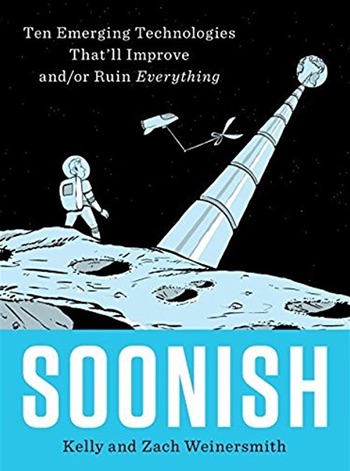 The real history of human science often mirrors the fictional history of science fiction. The term robot was first used in 1921 by the Czech writer Karel Capek in his play Rossum’s Universal Robots. In the 1940s, Isaac Asimov introduced the world to the Three Laws of Robotics. Today, robots are commonplace, and in fact science often outpaces the imaginative power of science fiction.
The real history of human science often mirrors the fictional history of science fiction. The term robot was first used in 1921 by the Czech writer Karel Capek in his play Rossum’s Universal Robots. In the 1940s, Isaac Asimov introduced the world to the Three Laws of Robotics. Today, robots are commonplace, and in fact science often outpaces the imaginative power of science fiction.
Yet for all the technological wonders of the 21st Century, many ideas remain firmly within the realm of science fiction, at least for now. Now, a new book from husband-wife duo Kelly and Zach Weinersmith explores the technology of the near future.
Zach is a cartoonish, while his wife Kelly is a scientist, and their collaboration Soonish details a host of futuristic concepts that could soon move from science fiction to science fact. Soonish: Ten Emerging Technologies That’ll Improve and/or Ruin Everything is an illustrated book that not only highlights these futuristic technologies but also examines their potential impacts on human society, for good or ill.
According to Jeff Foust of The Space Review, it’s a witty approach that puts a fun, accessible spin on complex technologies:
Each chapter takes on a technology with a mixture of seriousness and irreverence. They talk with experts and examine both the current state of the technology and its ramifications, positive and negative, should it become commonplace. They also have some fun with the subject matter, though, both in the text and with the frequent cartoons. That can be an interesting way to liven up dry, technical subject matter, but at times it can seem a little juvenile…
So what are the technologies of the soonish future?
One chapter explores the concept of a space elevator, which isn’t as outlandish as it sounds. While funding such a project would be difficult, the theory behind this form of transportation is viable. The International Space Elevator Consortium describes writes that a space elevator “can be thought of as a vertical railroad into space.” It would use cable connected to an orbitting counterweight in space. Elevators could then ferry ships, people, and supplies to a low-earth orbit, making fuel-guzzling rockets obsolete.
Today, there are roughly 900,000 elevators in the United States alone, and these vertical transports are generally 20 times safer than escalators. Of course, a space elevator remains a prospect for the Soonish future for now.
Other chapters include topics such as fusion power, robotic construction, synthetic biology, and neuro-computer interfaces. Keeping with the space theme, the book also explores the concept of drawing solar power from space, an idea included in an epiloguous “Graveyard of Lost Chapters.”
Ultimately, the Weinersmiths conclude that space-based solar power is an idea that sounds cool but is completely impractical. Simply put, terrestrial solar power is much more accessible. As of 2017, the U.S. has a solar power capacity of 47.1 gigawatts, which is enough to power 9.1 million homes.
While ideas like asteroid farming and space elevators may sound outlandish to some, the pace of technological change has been accelerating. So while not every technology in the book is likely to come to fruition, many ideas have already made the transition from science fiction to the real world.
When Einstein proved that time was relative, many laypeople scoffed at his absurd ideas. Today, the 31 satellites that make up the Global Positioning System contain highly accurate atomic clocks, and GPS wouldn’t be possible were it not for Einstein’s crazy theories on the relativity of time.
Dr. Kelly Weinersmith, a researcher with Rice University, and husband Zach Weinersmith, the artist behind the popular web comic Saturday Morning Breakfast Cereal, wrestle with questions like these in their new book. In spite of “mild goofery” and illustrated punchlines, NPR reviewer Tasha Robinson concludes that the book is largely “serious and informative.”
Soonish was published by Penguin Books.






